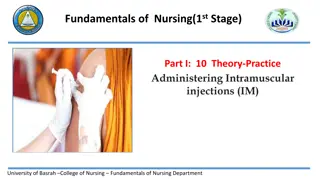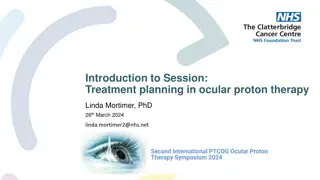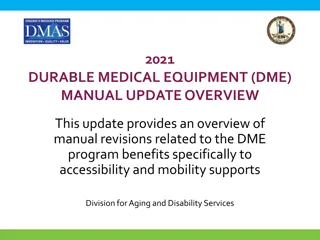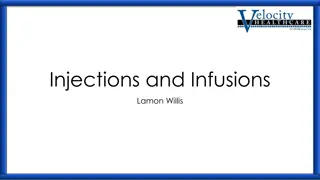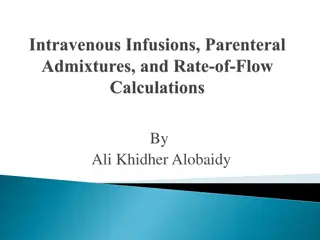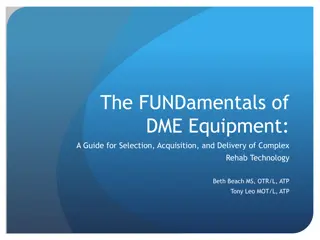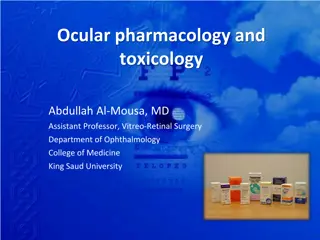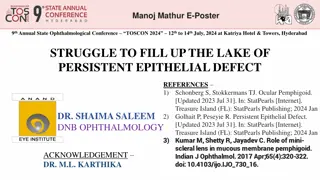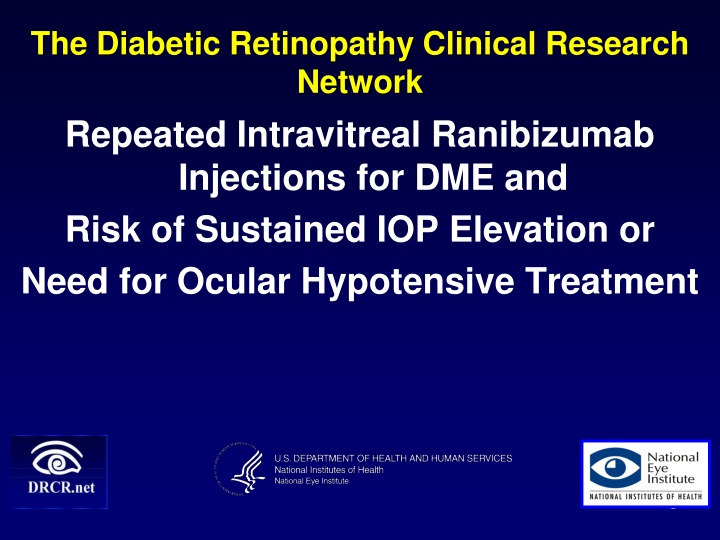
Repeated Intravitreal Ranibizumab Injections for DME: Risks and Ocular Treatment
This study from The Diabetic Retinopathy Clinical Research Network delves into the implications of repeated intravitreal ranibizumab injections for diabetic macular edema, focusing on the risk of sustained intraocular pressure elevation and the potential need for ocular hypotensive treatment. The research sheds light on critical considerations for managing DME patients undergoing such treatment protocols.
Download Presentation

Please find below an Image/Link to download the presentation.
The content on the website is provided AS IS for your information and personal use only. It may not be sold, licensed, or shared on other websites without obtaining consent from the author. If you encounter any issues during the download, it is possible that the publisher has removed the file from their server.
You are allowed to download the files provided on this website for personal or commercial use, subject to the condition that they are used lawfully. All files are the property of their respective owners.
The content on the website is provided AS IS for your information and personal use only. It may not be sold, licensed, or shared on other websites without obtaining consent from the author.
E N D
Presentation Transcript
The Diabetic Retinopathy Clinical Research Network Repeated Intravitreal Ranibizumab Injections for DME and Risk of Sustained IOP Elevation or Need for Ocular Hypotensive Treatment 1
Background Multiple reports suggest a small risk of sustained elevation of IOP with repeated injections of ranibizumab in eyes with AMD. Bakri, 2008: Graefes Ach; Adelman, 2010: J Ocu. Phar; Good, 2010 BJO; Choi, 2011:Retina Recent post hoc analysis of ANCHOR and MARINA data showed 11% of ranibizumab treated eyes had sustained IOP rise vs 5% in control eyes. Bakri et al, 2014: Ophthalmology RISE and RIDE, RESTORE did not identify difference in IOP-related adverse events in ranibizumab vs macular laser treatment groups. 2
DRCR.net Protocol I: Intravitreal Ranibizumab or Triamcinolone Acetonide in Combination with Laser Photocoagulation for Diabetic Macular Edema Trial (LRT-DME) Sham + Ranibizumab 0.5 mg + Prompt Laser Ranibizumab 0.5 mg + Deferred Laser Triamcinolone + Prompt Laser Prompt Laser Did not identify any differences in IOP ocular adverse events between ranibizumab and sham arms. 3
Purpose To explore DRCR.net Protocol I data for evidence of IOP concerns, including sustained elevation of IOP or need for IOP therapy, in ranibizumab groups in comparison with the prompt laser + sham injections group Ranibizumab 0.5 mg + Prompt Laser Ranibizumab 0.5 mg + Deferred Laser Sham + Triamcinolone + Prompt Laser Vs Prompt Laser 4
Primary Outcome Cumulative probability of Persistent Elevation of IOP through 3 years Persistent elevation of IOP definition: Any of the following: IOP 22 mm Hg with at least 6 mm Hg increase from baseline, at 2 consecutive visits, or Initiation of IOP-lowering medicine or procedure to lower IOP Threshold selection criteria was based on: usual" IOP range of 10 mm Hg to 21 mm Hg usual" IOP fluctuation typically less than 6 mm Hg Similar criteria used in prior studies of intravitreal injections 5
Visits Through the 52-week visit (1 year), protocol visits occurred every 4 weeks After year 1, visits varied from 4 to 16 weeks depending on response to treatment; analysis done only on every 16th-week visit (mandatory visits). 6
Data Exclusion / Censoring Exclude baseline IOP obtained post-dilation (10%) Exposure to corticosteroids of any source censored at date receiving steroid (29%) Sham eyes receiving anti-VEGF: eyes censored at date received anti-VEGF (12%) Eyes missing consecutive visits (5%) Vitrectomy censored at date of surgery (3%) 7 NVG or ghost cell glaucoma (1%)
Sham Ranibizumab N = 322* eyes Subjects Baseline Characteristics N = 260 eyes Age (yr), mean 63 63 Gender, Women, % 43% 43% Race, % White 72% 74% African American 18% 16% Hispanic 7% 7% Other 2% 2% Diabetes Duration (yr), mean 17 18 * and 8 Ranibizumab + Prompt Laser Ranibizumab + Deferred Laser
Ocular Baseline Characteristics Sham N = 260 Ranibizumab N = 322 IOP (mm Hg), mean IOP 22 to 24 mm Hg*, % IOP Device, % Goldmann Tonopen History of OHT/on IOP- lowering medicines 16 4% 16 5% 82% 18% 82% 18% 2% <1% 9 *Eligibility permitted IOP 24 mmHg
Primary Outcome Through 1 year Hazard Ratio (95%CI) Sham N = 260 Ranibizumab N = 322 Primary Outcome* Persistent IOP elevation/ Initiation of glaucoma med/surgery Persistent IOP elevation only 2.5 5 (2.0%) 10 (5.7%) (1.1 5.9) 1.4% 2.6% IOP-lowering medicine only 0.9% 1.8% Persistent IOP and IOP Med 0 1% Any glaucoma procedure Cumulative number of injections at meeting primary outcome, mean Note: Numbers changed slightly from ASRS 2013 presentation due to additional censoring primarily of data from patients receiving corticosteroids *from Time-To-Event analysis 0 0 2.2 5.4 (sham)
Outcome Through 3 years Sham N = 260 Ranibizumab N = 322 Hazard Ratio (95%CI) Primary Outcome* Persistent IOP elevation/ Initiation of glaucoma med/surgery Persistent IOP elevation only IOP-lowering medicine only Persistent IOP and IOP Med Any glaucoma procedure Cumulative number of injections at meeting primary outcome, mean 2.9 6 (3.4%) 22 (9.5%) (1.2 7.0) 1.1% 1.9% 0.4% 0 3.8% 3.1% 2% 0 6.7** *from Time-To-Event analysis ** Average cumulative # injections through 3 years 13.3
Cumulative Data 3 Years Sham N = 260 Ranibizumab N = 322 Number of visits median* Number of injections, median Proportion of eyes with IOP 30mmHg at any visit** Proportion of eyes with IOP change 10mmHg at any visit** Proportion of eyes with IOP change 10 mm Hg at 2 consecutive visits** 19 NA 19 12 3% 2% 9% 6% 1% 1% *every 4 wks through 1 year, then every 16 wks through 3 years **from any protocol visit 12
Mean Pre-Dilation IOP by Number of Injections at 3 Years 20 18 IOP mm Hg 16 14 12 N = 53 N = 58 N = 40 N = 108 10 8 1 (1-6) Quartiles of Number of Injections Through 3 years 2 (7-10) 3 (11-13) 4 (14-35) 13
Weaknesses Ad hoc review IOP may have been subject to diurnal fluctuations Different definitions of persistent DME may lead to different event rates Treating physicians unmasked to treatment groups potential bias May be more likely to treat eyes in the active injection groups 14
Strengths Subgroup of participants with 2 eyes in study 1 eye ranibizumab treated - 1 prompt laser Endogenous factors should be same Intravitreal injection eyes behave similar to overall cohort oHR 1.88 (8.5% sham vs 14.7% injection group) Carefully censored data to eliminate other causes of IOP effects. 15
Conclusion Protocol I data suggest that: Repeat injections of ranibizumab may be associated with increased risk of persistently increased IOP elevation as defined in this study in a relatively small percentage of treated patients Data would support recommendation to monitor IOP in similarly-treated eyes Unknown whether these data are similar for other anti-VEGFs used to treat DME Magnitude of increased IOP risk on central or peripheral vision remains unknown 16

